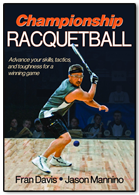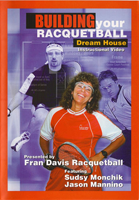 Video analysis is the BEST teaching/learning tool you can obtain. Like the saying “A picture is worth a thousand words,” I truly believe when you can see how you’re playing you can understand it, when you can understand it you can then make the necessary changes for improvement as you build your championship racquetball game.
Video analysis is the BEST teaching/learning tool you can obtain. Like the saying “A picture is worth a thousand words,” I truly believe when you can see how you’re playing you can understand it, when you can understand it you can then make the necessary changes for improvement as you build your championship racquetball game.
If you look at all sports like football, baseball, soccer, basketball, tennis, etc. the coaches all use video analysis in two ways:
1-to assess their own players and their own team’s game.
or
2-the players or teams they are going to be playing against.
I can tell athletes about their form, or footwork or shot selection, but it’s not until they see the videos that they say, “Wow, Fran you were right.” At my camps the participants rave about video analysis. They tell me, “I didn’t know that…I didn’t follow through on my forehand…bend my knees…relocate back into good center court position after the serve…” They are amazed at the weaknesses they see in other campers’ games in video, which can be exploited. My championship team CANNOT and WILL NOT live without it.
Video analysis could be a tremendous asset if done correctly and with someone who knows what they are looking for and can communicate how to make needed corrections. Below are areas of focus to help you get started. Use this list as a guide to what to zero in on when you are watching a match. Of course there are other areas, too. But in my opinion, these are the most crucial to giving you (more than) enough to start:
FOREHAND & BACKHAND MECHANICS
COURT POSITION & COVERAGE
SHOT SELECTION
SERVES
SERVICE RELOCATION
RETURN of SERVE
FOOTWORK
EMOTIONAL STATE
COMMENTS (Most Important)
Use the techniques in my book “Championship Racquetball”, Chapter 7 Developing Game Plans and Match Strategy, P. 190, for more details.
I have witnessed many of my players improve dramatically when studying and doing video analysis …let’s take a look.
Rocky Carson versus Alvaro Beltran: Semifinals, 2014 UnitedHealthcare US Open Racquetball Championships:
Rocky and Alvaro were tied at one game each. Alvaro was serving at 8-10 in the 3rd game. After a long rally, the referee made a two-bounce call on Rocky, awarding Alvaro the serve at 9-10. Rocky argued that he should have gotten a sideout, but the call was not overturned as there are no appeals in the men’s pro game. Instead of letting it go or calling a timeout, he lost the next 4 points and lost, 10-12.
When I first spoke with Rocky right after the tournament he didn’t think he let that call affect him. I asked Rocky to watch the video, and then call me to discuss. He changed his mind rather quickly once he saw the video.
Rocky Carson versus Ben Croft: Quarterfinals, 2014 Pete Pierce’s IRT St. Louis Party with the Pros
Ben was up on Rocky in the first two games of the match, but Rocky kept chipping away, against Ben’s lead. Toward the end of both games, Ben disagreed with calls against him, thinking they were bad calls. He did exactly what Rocky did with Alvaro at the US Open. As a result of letting Ben let the calls adversely affect him, he wound up losing the first two games. When Ben didn’t let the calls go, Rocky saw daylight and won the match, three games to one.
I had Rocky watch that match as well so he could see what happened and Rocky was surprised at what he saw and he called me after to discuss the match.
Jason Mannino vs. Everyone He Played
When I coached Jason, we watched video after video, both at the end of each half of the season and also at the end of each full season. We sat down for hours and went over each match until we tweaked everything in his game: physical, mental, and emotional. We also studied matches in the middle of his season at our camps. We used the same 9 areas in our analysis that I have given to you on the chart for your analysis. Jason believes this was the most IMPORTANT factor that helped him move up from being in the top 4 to finishing #1 on the IRT rankings for the 2002/2003 season.
Video Analysis is yet another required skill on the road to championship pro racquetball. ALL of the players I coach, from the professionals led by Rocky and Paola to the amateurs, know just how important it is to watch and analyze their own games as well as their opponents’ games. It’s sometimes not easy, but a MUST. Their records speak for themselves…Rocky and Paola are BOTH 2 of the most decorated athletes in racquetball. Paola finished the 2013-2014 ranked #1 on the LPRT for the 3rd consecutive season, was crowned the IRF 2014 World Champion, and is the 5-time US Open Champion. Rocky finished the 2013-2014 ranked #2 on the IRT, was crowned IRF 2014 World Champion, and 2014 World Outdoor Champion.
Next month, I will continue to build your Championship Racquetball Game one level at a time so you too can be ready to become the champion you always dreamed of becoming, by giving you the tools to make it a reality. Rocky on the International Racquetball Tour (IRT) and all my athletes “Championship Racquetball Games” stem from their focus on ALL 3 sides of the triangle working together so they can develop into top competitors. Without a shadow of a doubt, they KNOW just how important it is to do the work. They are living proof it works and their titles substantiate it.
For details on more personalized instruction, a weekend camp, instructional DVD’s, our book, Championship Racquetball, and our APP (coming soon), ALL which covers all aspects of the Sports Racquetball Triangle and more, please visit www.FranDavisRacquetball.com. Fran Davis is a 2004 racquetball Hall of Fame inductee; Racquetball Woman of the Year 2009; Coach of Rocky Carson the #2 IRT Pro Player, 1-time US Open Champion, plus 4-time and defending IRF World Champion; #1 LPRT Pro Player Paola Longoria, 5-time and defending US Open Champion, plus IRF World Champion; and Coach of Taylor Knoth, Jr. World & National Champion, Intercollegiate Champion, & IRT Pro Player; Coach Intercollegiate Champion & LPRT Pro Player, Sharon Jackson; Master Professional Instructor/Coach USAR-IP.










